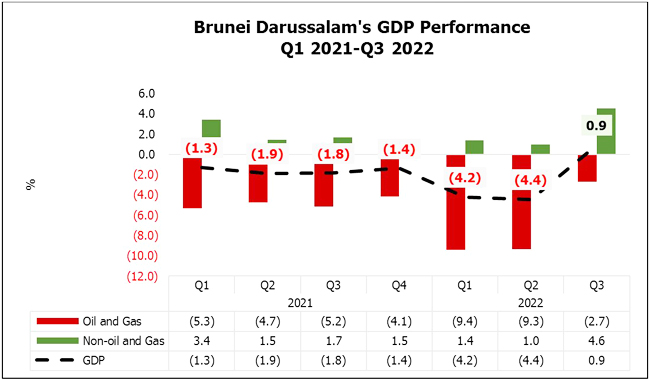[ad_1]
In the third quarter (Q3) of 2022, Brunei Darussalam’s gross domestic product (GDP) by economic activity was mainly contributed by the industry sector which was about 66.4 per cent. This was followed by services sector by 32.5 per cent and agriculture, forestry and fishery sector by 1.1 per cent.
The Sultanate’s GDP at current prices in Q3 2022 was valued at BND5.8 billion compared to BND4.7 billion in Q3 2021. The oil and gas sector, comprising of oil and gas mining and manufacture of liquefied natural gas (LNG), accounted for 51.7 per cent of the total gross value added (GVA). Meanwhile, the non-oil and gas sector, which includes downstream activities such as the manufacture of petroleum and chemical products, contributed 48.3 per cent of GDP.
Meanwhile, GDP value at constant prices recorded a growth of 0.9 per cent year-on-year.
This was due to an increase in the non-oil and gas sector by 4.6 per cent. On the other hand, the oil and gas sector decreased by 2.7 per cent.
The non-oil and gas sector remained positive with an increase in the subsectors such as downstream, finance, air transport, wholesale and retail trade, and fishery.
An increase in the downstream activities was due to increased methanol production by 16.1 per cent, from 129,778 metric tonnes in Q3 2021 to 150,674 metric tonnes in Q3 2022 as well as the new production of the chemical product, specifically urea fertiliser.

Meanwhile, the increase in the finance subsector was in line with an increase in the income of financial and banking activities.
The increase in transport subsector was mainly contributed by the rise in air transport. The increase in air transport activity was in line with the increase in passenger air arrivals, from 4,494 in Q3 2021 to 79,730 in Q3 2022; and air departures, from 8,140 in Q3 2021 to 71,595 in Q3 2022, which corresponded to permission to enter and exit the country.
The increase in the wholesale and retail trade subsector was due to the rise in domestic demand in line with the reduction in control measures following the cessation of the COVID-19 Early Endemic Phase as opposed to the third quarter (Q3) in the previous year, in which most movement restrictions were reinstated to control the spread of COVID-19. The increase in this subsector was also in line with the rise in retail sales mainly driven by an increase in sales of textiles, wearing apparel and footwear cent, sales of hardware, paints and glass in specialised stores and sales at petrol station.
Furthermore, the increase in the fisheries subsector resulted from the expansion of the capture and aquaculture industries. The growth of the capture industry was primarily attributable to small-scale fishermen’s activities. Meanwhile, farm prawn was the main contributor to the aquaculture industry.
However, the decline in the oil and gas sector was due to a decrease in the production of crude oil from 97.1 thousand barrels per day in Q3 2021 to 86.2 thousand barrels per day in Q3 2022. Natural gas production also recorded a decrease from 28.7 million cubic metres per day in Q3 2021 to 28 million cubic metres per day in Q3 2022. The reduction in crude oil and natural gas production was due to schedule and unscheduled maintenance and rejuvenation activities for the offshore platform. This has limited the natural gas supply to the Liquefied Natural Gas (LNG) plant and caused low gas intake for the purpose of LNG production. In addition, maintenance activities were also carried out at the LNG plant, thus, LNG production has declined from 750,944 MMBtu per day in Q3 2021 to 731,975 MMBtu per day in Q3 2022.
By expenditure approach, an increase in GDP growth in Q3 2022 was due to a rise in the exports of goods and services by 14.3 per cent, mainly the export of mineral fuel goods. This was followed by an increase in the household final consumption expenditure (12.2 per cent), private gross capital formation (2.4 per cent), and government final consumption expenditure (0.4 per cent).
The full report is available from deps.mofe.gov.bn.
[ad_2]
Source link








